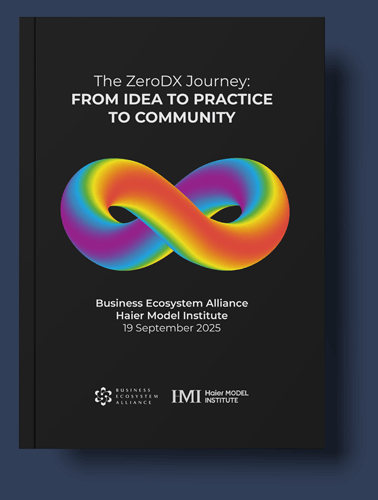Haier’s Evolution Toward an Ecosystem of Ecosystems: Reflections from the RenDanHeYi Model Forum 2024
By Dr.-Ing. Janka Krings-Klebe
Haier, a global leader in consumer electronics and home appliances, has long been recognized for its innovative organizational models. In recent years, the company has been redefining its approach to value creation by shifting focus from individual entrepreneurial efforts to collaborative problem-solving within ecosystems. This evolution reflects a broader understanding that in today's highly interconnected world, addressing complex customer needs requires collective action and seamless collaboration. Recognizing this complexity, Zhang Ruimin, founder of Haier and chairman emeritus of the board of directors of Haier Group, first established the RenDanHeYi model, which transformed the company into a network of Micro-enterprises (MEs). These Micro-enterprises work like independent startups within the larger organization, each empowered to respond swiftly to market demands. While this model fostered innovation and rapid market adaptation, Haier soon realized that individual efforts were not enough to meet the multiple challenges created by today's markets. To address larger customer scenarios, such as smart living solutions, that go beyond the capabilities of single Micro-enterprisess, Haier created Ecosystem Micro-Communities (EMCs). These communities align multiple Micro-enterprisess towards a shared purpose, facilitating collaboration and leveraging collective strengths. This shift marked a move from isolated value creation to a more integrated approach, that focusses on solving problems within specific ecosystems, such as smart living.
Building on this foundation, the logical next step is to enhance those ecosystems by making them permeable at their boundaries, allowing for seamless collaboration and interaction not only within a specific ecosystem and business domain but also with external partners and even other ecosystems. By dissolving traditional organizational barriers, Haier fosters an environment where ideas, resources, and innovation can flow freely, enabling the co-creation of value on a much larger scale. An illustrative example of this strategy is COSMOPlat, Haier's industrial internet platform. While COSMOPlat is renowned for facilitating mass customization in manufacturing, its scope extends far beyond that. COSMOPlat plays a pivotal role in the digital transformation of industrial energy parks, promoting green and low-carbon high-quality development. By integrating energy management systems with IoT technologies, COSMOPlat helps industrial parks optimize energy consumption, reduce emissions, and enhance operational efficiency. This not only benefits individual enterprises but also contributes to broader environmental sustainability goals.
But the collaboration potential of ecosystems does not stop there, in the domain of industrial business: Haier now extends its ecosystem into urban management. Its digital IoT technology platform Hai Na Yun for example integrates various urban systems — such as urban security, urban operation management, infrastructure construction and maintenance, and transportation — into a unified platform. By leveraging IoT, big data, AI and digital twin technologies, this enables city administrators to make informed decisions, improve resource allocation, and enhance the quality of urban life.
In addition, Incaire is Haier’s Ecosystem Brand in the healthcare industry that specializes in life sciences, clinical medicine, and biotechnology. It boasts three listed companies: Haier Biomedical, Incaire Life Sciences, and Shanghai RAAS. Incaire connects various ecosystem parties such as laboratories, universities, scientists, medical experts, hospitals, fund investments, and upstream and downstream industrial chains and is developing a leading medical and engineering technology integration platform, CPHE (Convergence Platform of Healthcare Ecosystem). With its “Near-Shore R&D Model”, CPHE not only accelerates the leap of medical and technological achievements from the laboratory to the market but also leads the vigorous development of original technological innovations in life and health. Its core advantage lies in building a highly collaborative, open, and shared intelligent interactive ecosystem that effectively addresses the numerous obstacles in the transformation of scientific and technological achievements. This enables a rapid transition from scientific research innovation to clinical application, achieving a win-win evolution in user experience value, scientific research value for scientists, and business value for enterprises.
All these approaches exemplify how Haier's multiple ecosystems overlap with and contribute to larger contexts like smart cities, which require the integration of various specialized ecosystems such as energy, transportation, healthcare, and communication systems.
However, when venturing into overlapping ecosystems one of the main obstacles in such a setting is governance. Traditional governance models are inadequate for managing the complexities of interconnected ecosystems: Their boundaries are fluid, and the interests of participating stakeholders are very diverse, ranging from strictly local to global, from various business sectors to public sectors, and from collaboration in certain domains to competition in others. Effective governance in this context must address several critical areas:
- Coordination and shared value creation: Aligning the objectives of various stakeholders is essential. Governance structures must facilitate coordination among ecosystem stakeholders, ensuring that all parties work towards a shared purpose and contribute to collective value creation. This includes establishing mechanisms for shared profiting, where the benefits of collaboration are distributed fairly, sustaining motivation and fostering long-term partnerships.
- Interoperability: Seamless collaboration across ecosystems requires interoperability at both technical and organizational levels. Governance must promote the adoption of common standards, protocols, and platforms that enable trust and allow different systems and entities to work together effectively. This is particularly important in the IoT era, where devices and services need to communicate and operate in harmony.
- Protection of proprietary knowledge: While openness and collaboration are crucial, protecting sensitive information and intellectual property remains vital. Governance policies must balance the need for transparency with security measures that safeguard proprietary knowledge. Clear guidelines on data sharing, confidentiality, and IP rights are necessary to build trust among participants.
- Adaptive governance models: In a rapidly changing environment, governance structures need to be flexible and adaptive by default.
Haier's commitment to a "zero boundaries" approach reflects an understanding that the future lies in collaborative ecosystems. By making their ecosystem boundaries permeable, they enable the free flow of ideas, resources, and innovations, which is essential for addressing complex challenges like those presented by smart cities. However, this also means that governance becomes more critical and much more challenging.
In the IoT era, where devices, systems, and services are increasingly interconnected, traditional governance models are insufficient. Effective governance must facilitate not just internal coordination but also external collaboration across different ecosystems. It requires innovative approaches that can handle the dynamic and decentralized nature of these networks. Most importantly, it requires mechanisms to effectively and efficiently govern a multitude of highly diverse actors in a wide variety of collaboration cases. These scenarios inevitably create conflicts of interests. They can only be solved by having fast, effective, transparent, and widely accepted mechanisms for bringing conflicts of interest to negotiating tables and resolving them in an acceptable manner for the involved parties.
In conclusion, adaptable ecosystem governance emerges as the critical factor that can enable or hinder success of collaboration in ecosystems. Effective governance ensures coordination, promotes shared value creation, facilitates interoperability, and protects specific and collective interests of stakeholders, like e.g. proprietary and shared knowledge – all of which are essential in the interconnected IoT landscape. Haier's experience serves as a forerunner in this regard. Its example shows how organizations can adapt their governance models to meet the demands of a rapidly evolving market, ultimately contributing to more sustainable and innovative solutions for complex global challenges.
海尔向“生态系统之生态系统”的演进:2024年人单合一模式论坛的思考
詹卡·柯林斯·克勒贝(Janka Krings-Klebe)
海尔是全球消费电子和家电行业的领导者,长期以来以其创新的组织模式而闻名。近年来,该公司一直在重新定义其价值创造的方式,将重点从个人的创业努力转变为在生态系统内协同解决问题。这一演变反映了更为广泛的认识:在当今这个高度互联的世界,解决复杂的用户需求需要集体行动和无缝协作。认识到这种复杂性,海尔创始人、海尔集团董事局名誉张瑞敏首次提出了人单合一模式,该模式将海尔转变为由众多小微组成的网络。这些小微在更大的组织内就像独立的创业公司一样运作,每个小微都被赋予快速响应市场需求的权力。虽然这一模式促进了创新和快速适应市场,但海尔很快意识到,仅凭个体努力不足以应对当今市场带来的多重挑战。为了应对超出单一小微能力范围的更大用户场景,如智慧家庭解决方案,海尔创新了链群组织。这些链群使多个小微围绕共同目标协同一致,促进合作并发挥集体优势。这一转变标志着海尔从单一的价值创造向更加集成的方式转变,更加专注于在特定的生态系统(如智家)内解决问题。
在此基础上,下一步的必然发展是进一步强化这些生态系统,使它们的边界变得更具通透性,从而不仅能在特定生态系统和业务领域内部实现无缝协作与交流,还能轻松与外部合作伙伴乃至其他生态系统进行互动。海尔通过打破传统组织界限,营造了一个思想、资源和创新自由流动的环境,极大地促进了价值的共创。海尔的工业互联网平台“卡奥斯”便是这一战略的一个绝佳例证。卡奥斯不仅因推动制造业的大规模定制而广受赞誉,其影响力还远远超出了这一范畴。它在工业园区的数字化转型中发挥着核心作用,有力推动了绿色、低碳的高质量发展。通过整合能源管理系统与物联网技术,卡奥斯助力工业园区优化能源使用、减少排放并提升运营效率。这不仅为单个企业带来了益处,更为实现更广泛的环境可持续性目标做出了贡献。
海尔的生态系统协作潜力并未止步于工业商业领域,而是进一步扩展到了城市管理的新天地。以“海纳云”这一数字物联科技平台为例,它巧妙地将城市安全、城市运行管理、基础设施建造运维、交通运输等等城市系统融为一体,形成了一个统一的智能平台。借助物联网、大数据、AI算法和数字孪生的强大力量,城市管理者得以做出更加精准、科学的决策,资源分配效率显著提升,城市生活的品质也随之跃升。
海尔的盈康一生是海尔集团旗下大健康生态品牌,深耕生命科学、临床医学、生物科技三大领域,拥有海尔生物、盈康生命、上海莱士3家上市公司。盈康一生链接实验室、高校、科学家、医学家、医院、基金投资、上下游产业链等生态各方,创新性地构建了领先的医工科技融合平台——海医汇生态。通过首创“近岸研发”模式,这一平台不仅加速了医学科技成果从实验室到市场的飞跃,更引领了生命健康原创科技的蓬勃发展。其核心优势在于,通过构建一个高度协同、开放共享的智能交互生态系统,有效解决了科技成果转化中的重重障碍,实现了从科研创新到临床应用的高速跨越,实现用户体验价值、科学家科研价值和企业商业价值的共赢进化。
海尔所采取的这一系列策略,生动诠释了其多个生态系统如何与智慧城市等更宏大框架相融合,共同推动其发展。智慧城市的构建,离不开能源、交通、医疗健康、通信系统等多样化专业生态系统的深度整合。
然而,在探索相互交织的生态系统时,治理成为了主要挑战之一。传统的治理模式难以应对这种互联生态系统的复杂性,因为它们的边界模糊,且利益相关者的利益诉求极为多样,涵盖了从地方到全球、从商业到公共部门、从某些领域的合作到其他领域的竞争等各个层面。因此,在此背景下实现有效治理,必须妥善解决以下几个关键领域的问题:
- 协调与共创价值:协调各利益相关者的目标是至关重要的。治理体系必须促进生态系统内各利益相关者的协调,确保各方朝着共同的目标努力,并为集体价值的创造做出贡献。这包括建立共享收益机制,确保合作成果得到公平分配,从而维持合作动力,促进长期合作伙伴关系的建立。
- 互操作性:生态系统间的无缝协作需要在技术和组织层面都具备互操作性。治理体系必须推动采用共同的标准、协议和平台,以建立信任,使不同的系统和实体能够有效合作。在物联网时代,这一点尤为重要,因为设备和服务需要和谐地通信和运作。
- 专利知识保护:虽然开放和协作至关重要,但保护敏感信息和知识产权同样重要。治理政策必须在透明度的需求和保护专利知识的安全措施之间取得平衡。制定明确的数据共享、保密和知识产权指南,对于建立参与者之间的信任至关重要。
- 适应性治理模型:在快速变化的环境中,治理体系必须默认具备灵活性和适应性。
海尔秉持的“零边界”理念,深刻体现了对未来协作生态系统的洞察。通过让生态系统边界变得开放且富有流动性,海尔促进了思想、资源和创新的自由交换,这对于解决诸如智慧城市所带来的复杂挑战而言至关重要。然而,这也使得治理工作变得更为关键且极具挑战性。
步入物联网时代,随着设备、系统与服务间的互联愈发紧密,传统治理模式已难以满足需求。有效的治理机制不仅要强化内部协调,还需促进不同生态系统间的外部协同合作。为此,需采用创新手段应对这些网络所展现出的动态与去中心化特性。尤为关键的是,要构建一套机制,确保能在各种合作场景中高效、有序地管理众多高度多元化的参与者。面对这些场景中不可避免的利益冲突,唯有通过迅速、高效、透明且广受认可的机制,将冲突摆上谈判桌,并以各方满意的方式予以解决,方能实现和谐共进。
综上所述,适应性的生态系统治理是决定生态系统合作成败的关键所在。有效的治理机制不仅能确保各方协调一致,还能推动价值共创,促进系统间的互操作性,并妥善保护利益相关者的专属及共同利益,如专利知识和共享信息等,这些在物联网互联互通的背景下显得尤为重要。海尔的实践为此树立了典范,展示了企业如何调整治理模型,以应对快速变化的市场需求,从而为解决复杂的全球挑战提供更为可持续和创新的方案。


